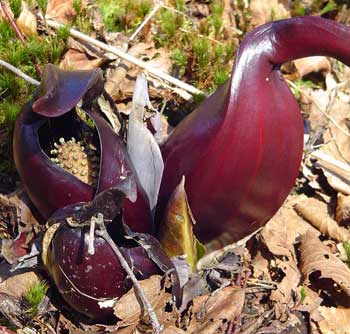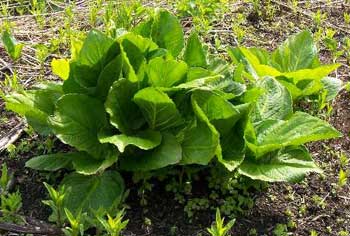Contents:
Common Names | Parts Usually Used | Plant(s) & Culture | Where Found | Medicinal Properties
Uses | Formulas or Dosages | Warning | Bibliography
Scientific Names

- Symplocarpus foetidus L.
- Arum family
Common Names
- Collard
- Fetid hellebore
- Meadow cabbage
- Polecat weed
- Skunk weed
- Stinking poke
- Swamp cabbage
Parts Usually Used
Rootstock; roots and seed
Back to Top

Description of Plant(s) and Culture
A strongly skunk-scented perennial plant; 1-2 feet tall, of the arum family, having large, cabbagelike leaves, a spadix of small flowers concealed in a purple, hooded spathe, and a disagreeable smell. The large tuberous rootstock produces fleshy roots and heart-shaped, cabbage-like leaves on thick leafstalks. Numerous small, purple flowers grow on a small, oval, fleshy spike (or spadix), covered by a purple and yellowish-green, hoodlike bract (or spathe). Flowering time is from February to April, before the leaves appear. The whole plant emits a skunk or garlic odor.
In the north, the unusual reddish green blooms of skunk cabbage are among the first wildflowers to appear in spring. February to May. Temperature within the flower spathe is often 60 degrees F. higher than the ambient air; the flower may melt snow as it begins to bloom.
Back to Top
Where Found
Grows in wet rich soil in swamps of eastern North America, as far west as Manitoba and Iowa.
Back to Top
Medicinal Properties
Antispasmodic, diuretic, emetic, diaphoretic, expectorant, slightly narcotic, stimulant
Back to Top
Uses
The rootstock and roots of skunk cabbage have been used to treat respiratory ailments, including: hay fever, asthma, whooping cough, bronchial problems, and mucous congestion. It is helpful for nervous disorders, spasmodic problems, rheumatism, and dropsy. Some Native Americans boiled the root hairs to make a wash for stopping external bleeding. One tribe inhaled the odor of the crushed leaves to cure headache or toothache (which may be a classic case of a cure worse than the disease). Root poulticed for wounds, underarm deodorant; leaf poulticed to reduce swelling, they ate the root to stop epileptic seizures.
Very reliable in tuberculosis, chronic catarrh, fevers, whooping cough, epilepsy, convulsions, and pleurisy. Excellent remedy in dysentery, convulsions, dropsy, hysteria, epilepsy, and for use during pregnancy.
When made into an ointment, it greatly relieves the pain of all external tumors and sores.
Back to Top
Formulas or Dosages
Infusion: steep 1 tsp. rootstock and roots in 1 cup water for 1/2 hour. Take 1 cup per day, a tbsp. at a time.
Skunk cabbage loses effectiveness with long storage.
Back to Top
Warning
The fresh plant has acrid properties. Eating leaves causes burning, inflammation. Roots considered toxic.
Use under medical supervision only.
Back to Top
Bibliography
![]() Back to Eden
Back to Eden, by Jethro Kloss; Back to Eden Publishing Co., Loma Linda, CA 92354, Original copyright 1939, revised edition 1994
![]() The Herb Book
The Herb Book, by John Lust, Bantam Books, 666 Fifth Avenue, New York, NY. copyright 1974.
![]() Indian Herbalogy of North America
Indian Herbalogy of North America, by Alma R. Hutchens, Shambala Publications, Inc., Horticultural Hall, 300 Massachusetts Avenue, Boston, Massachusetts 02115, 1973
![]() Eastern/Central Medicinal Plants
Eastern/Central Medicinal Plants, by Steven Foster and James A. Duke., Houghton Mifflin Company, 215 Park Avenue South, New York, NY 10000
![]() Planetary Herbology
Planetary Herbology, by Michael Tierra, C.A., N.D., O.M.D., Lotus Press, PO Box 325, Twin Lakes. WI 53181., Copyright 1988, published 1992
![]() American Folk Medicine
American Folk Medicine, by Clarence Meyer, Meyerbooks, publisher, PO Box 427, Glenwood, Illinois 60425, 1973
![]() The Yoga of Herbs: An Ayurvedic Guide to Herbal Medicine
The Yoga of Herbs: An Ayurvedic Guide to Herbal Medicine, by Dr. David Frawley & Dr. Vasant Lad, Lotus Press, Twin Lakes, Wisconsin, Second edition, 1988.
![]() Webster’s New World Dictionary
Webster’s New World Dictionary, Third College Edition, Victoria Neufeldt, Editor in Chief, New World Dictionaries: A Division of Simon & Schuster, Inc., 15 Columbus Circle, New York, NY 10023
 The Rodale Herb Book: How to Use, Grow, and Buy Nature’s Miracle Plants (An Organic gardening and farming book)
The Rodale Herb Book: How to Use, Grow, and Buy Nature’s Miracle Plants (An Organic gardening and farming book), edited by William H. Hylton, Rodale Press, Inc. Emmaus, PA, 18049., 1974
